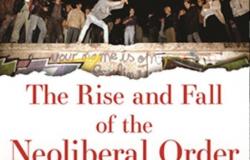The end of the great order under the Heaven

A review of Gary Gerstle’s “The Rise and Fall of the Neoliberal Order”.
The very well-written and easy to read book by Gary Gerstle (The Rise and Fall of the Neoliberal Order) makes two key points. First, and continuing from Gerstle’s previous book (The Rise and Fall of the New Deal Order, coauthored with Steve Fraser) it insists on the idea of a political and economic “order”. An “order” is the ruling ideology at a given point in time, synthesized and propagated by the most important parts of the political establishment. There were, according to Gerstle two such political orders in the United States during the past century: the New Deal order that began with Franklin Delano Roosevelt, and the neoliberal order that began with Ronald Reagan.
Second, these two political orders are related, in an almost ideally synchronized manner, with the rise and fall of communism. This is not an accident. The external (international) context played an important role in the design of the US political orders.
 How does an ideology become a “political order”? There is a “silent phase” of order’s construction that involves intellectuals and their theories. For neoliberalism, we have to go back to the Walter Lippmann’s Paris Colloquia, and Hayek’s and Mises’ Vienna and then more recently to Milton Friedman, Thomas Sowell, Charles Murray, Rush Limbaugh…Consider the years: Heritage Institution founded in 1974, Cato Institute 1974, Manhattan Institute 1976, Moral Majority defined in 1979. Ideology is then propagated throughout the public and gets adopted by one or several political movements and parties. It does not become an “order” however until it gets accepted, or, as Gerstle likes to write, until it is “acquiesced to” by other parts of the political spectrum that at first rejected it. (Margaret Thatcher is cited as saying that her greatest success was that her policies were continued by Tony Blair.)
How does an ideology become a “political order”? There is a “silent phase” of order’s construction that involves intellectuals and their theories. For neoliberalism, we have to go back to the Walter Lippmann’s Paris Colloquia, and Hayek’s and Mises’ Vienna and then more recently to Milton Friedman, Thomas Sowell, Charles Murray, Rush Limbaugh…Consider the years: Heritage Institution founded in 1974, Cato Institute 1974, Manhattan Institute 1976, Moral Majority defined in 1979. Ideology is then propagated throughout the public and gets adopted by one or several political movements and parties. It does not become an “order” however until it gets accepted, or, as Gerstle likes to write, until it is “acquiesced to” by other parts of the political spectrum that at first rejected it. (Margaret Thatcher is cited as saying that her greatest success was that her policies were continued by Tony Blair.)
In the case of the United States, the crucial moments of transition from ideology and political movement to order happened under Dwight Eisenhower who (as opposed to, say, William Taft) was ready to continue with the New Deal policies despite the fact that Republicans were originally opposed to all FDR stood for. And likewise, it is thanks to Bill Clinton that neoliberalism became a political and economic “order”. A given political order when it is at its peak appears like common sense. It is hardly questioned. Large majorities of the public opinion support it even if they might disagree on peripheral (from the point of view of economic order) issues.
For Gerstle, the neoliberal order in the US went from Reagan in 1980 until at least the Great Recession when its decomposition began, and it ended in the first and second decades of the 21st century. Trump, and more importantly, the silent ideological preparation for something new (J.D. Vance and Steve Bannon?; the latter, by the way, unmentioned), and the glaring defects of the neoliberal order prepared its ending. What that new order will be is left unclear though.
The argument regarding the importance of Communism for the definition of the two orders is strongly made, and makes lots of sense. As Gerstle writes, too much attention in the 1950s was paid to Democrats trying not to appear soft on communism, and too little attention to Republicans accepting most of the acquis of the New Deal in return for safety of private property. (“The threat of international communism made possible the transition of the New Deal from political movement to political order and ensured its dominance in American life for 30 years”, p. 46).
With the declining appeal of communism and then its eventual fall, there was much less need to acquiesce to labor’s demands. Labor had nowhere to go, or dream that it could go, or threaten to go. Reagan’s firing of thousands of air-controllers was the opening salvo of the war on labor. (Globalization and outsourcing to China might have been the second.) This argument is worth making, but is not new. Krishnan Nayar has forcefully argued the same point in his excellent but neglected book Liberal Capitalist Democracy, and not only with regard to the United States but the entire political West (I reviewed Nayar’s book here.) Piketty, although less openly, has expressed the same idea by showing that capitalism’s “tame period” coincided with the crest of power of communist and socialist parties and trade unions in Western Europe. Recently, André Albuquerque Sant’Anna has, in an important paper, tested the proposition empirically and confirmed the hypothesis.
Gerstle’s book however is limited in showing only the effect of the rest of the world on the United States, not the converse. In fact, the US was a key actor in making the neoliberal order go global. There too Reagan and the Volcker shock (Volcker, by the way, was appointed by Carter) exerted crucial influence. They brought to order, metaphorically and often physically, Latin America, Africa and Eastern Europe. When Clinton made neoliberalism the American political and economic order, he also made its rule global. That aspect is entirely absent from Gerstle’s book. Even when the rest of the world appears, as very briefly with Gorbachev and more extensively with the Iraq war fiasco, it is seen through the US prism only. This is not a shortcoming of the book because the book tells the story of US ideology and politics over the past century, but might have been pointed out more clearly in the title. The subtitle “America and the World in the Free Market Era” is a bit misleading simply because there is no “world” in the book. “America in the Free Market Era” would have been a more accurate description of the book’s content.
The Clinton presidency takes almost 50 pages of a 300-page book. It shows Clinton cleverly concluding that a return to New Deal policies is impossible, espousing and deepening neoliberalism. Gerstle discusses Clinton’s extremely important decisions regarding deregulation of information and communication industry and banking, both related to Clinton’s famous “triangulation” strategy: the realization that he (and Democrats) cannot rule without the support of Silicon Valley and Wall Street. Clinton got both on his side by giving them what they wanted, and (as Gerstle writes) by deregulating much more than Reagan. In addition, he reduced the US welfare state and balanced the budget. Inequality continued to go up but less than under Reagan.
Clinton’s role is absolutely central. The rest is the “details”. W. Bush is excoriated for his cavalier treatment of the housing bubble and looming financial crisis, and even more so for his decision to invade Iraq and then do nothing. Both, Gerstle argues, were based in W. Bush’s quasi-religious belief in markets: one need not do anything: markets will fix all. No need to worry about the bad loans; if banks divide them into small enough portions and find buyers for them, the risk will magically disappear. It was “voodoo economics” as his father, in a different context, rightly called it. The approach to the war on Iraq was the same: no need to prepare anything past the military campaign: just leave it to the market forces, and the happy Iraqis, free from Saddam, will transform the country into a new Hong Kong. I think however that W. Bush simplistic beliefs were grounded in his unbelievable intellectual laziness: a privileged, spoiled and not too smart boy never grew up and never showed the slightest interest to learn anything about anybody but PLU (“people like us”).
Obama’s presidency is shown as inconsequential. One has hard time believing, when reading the book, that it lasted the full eight years. Obama, as is well known, picked up all the economic Clintonites whose neoliberalism was by now a pale copy of the past. While under Clinton they all appear (allegorically) wearing beautiful new blazers, under Obama, the same people are dressed in the second-hand threadbare jackets of late neoliberalism.
And what to say about Trump? As little as possible. Gerstle’s book there suddenly runs out of steam. This is understandable because he argues that neoliberalism has come to a dead-end, but neither he nor anyone else can divine what the next “order” will be. The last chapter (that includes both Trump and Biden presidencies) is the weakest. It simply retells the main events, and rehashes the cliches about Trump. Perhaps it was written too early…
This first appeared on Branko's blog.


